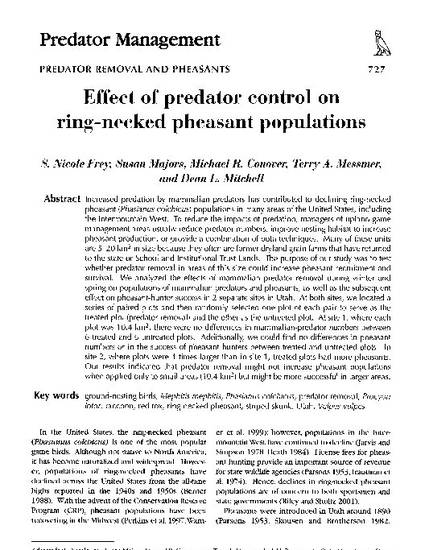
Article
Effect of Predator Control on Ring-Necked Pheasant Populations
Wildlife Society Bulletin
(2003)
Abstract
Increased predation by mammalian predators has contributed to declining ring-necked pheasant (Phasianus colchicus) populations in many areas of the United States, including the Intermountain West. To reduce the impacts of predation, managers of upland-game management areas usually reduce predator numbers, improve nesting habitat to increase pheasant production, or provide a combination of both techniques. Many of these units are 5-20 km² in size because they often are former dryland grain farms that have returned to the state or School and Institutional Trust Lands. The purpose of our study was to test whether predator removal in areas of this size could increase pheasant recruitment and survival. We analyzed the effects of mammalian predator removal during winter and spring on populations of mammalian predators and pheasants, as well as the subsequent effect on pheasant-hunter success in 2 separate sites in Utah. At both sites, we located a series of paired plots and then randomly selected one plot of each pair to serve as the treated plot (predator removal) and the other as the untreated plot. At site 1, where each plot was 10.4 km², there were no differences in mammalian-predator numbers between 6 treated and 6 untreated plots. Additionally, we could find no differences in pheasant numbers or in the success of pheasant hunters between treated and untreated plots. In site 2, where plots were 4 times larger than in site 1, treated plots had more pheasants.
Disciplines
Publication Date
2003
Citation Information
Terry A. Messmer. "Effect of Predator Control on Ring-Necked Pheasant Populations" Wildlife Society Bulletin Vol. 31 Iss. 3 (2003) p. 727 - 736 Available at: http://works.bepress.com/terry-messmer/243/
